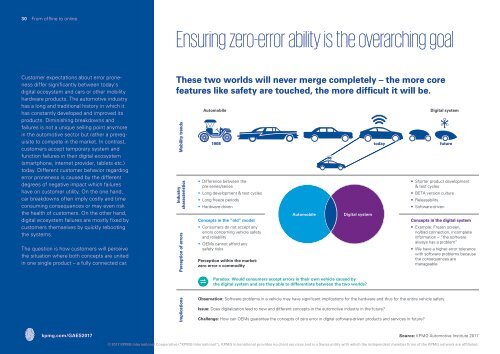Global Automotive Executive Survey 2017
global-automotive-executive-survey-2017
global-automotive-executive-survey-2017
Create successful ePaper yourself
Turn your PDF publications into a flip-book with our unique Google optimized e-Paper software.
30 From offline to online<br />
Ensuring zero-error ability is the overarching goal<br />
Customer expectations about error proneness<br />
differ significantly between today’s<br />
digital ecosystem and cars or other mobility<br />
hardware products. The automotive industry<br />
has a long and traditional history in which it<br />
has constantly developed and improved its<br />
products. Diminishing breakdowns and<br />
failures is not a unique selling point anymore<br />
in the automotive sector but rather a prerequisite<br />
to compete in the market. In contrast,<br />
customers accept temporary system and<br />
function failures in their digital ecosystem<br />
(smartphone, internet provider, tablets etc.)<br />
today. Different customer behavior regarding<br />
error proneness is caused by the different<br />
degrees of negative impact which failures<br />
have on customer utility. On the one hand,<br />
car breakdowns often imply costly and time<br />
consuming consequences or may even risk<br />
the health of customers. On the other hand,<br />
digital ecosystem failures are mostly fixed by<br />
customers themselves by quickly rebooting<br />
the systems.<br />
The question is how customers will perceive<br />
the situation where both concepts are united<br />
in one single product – a fully connected car.<br />
These two worlds will never merge completely – the more core<br />
features like safety are touched, the more difficult it will be.<br />
Mobility trends<br />
Industry<br />
characteristics<br />
Perception of errors<br />
Automobile<br />
• Difference between the<br />
pre-series/series<br />
• Long development & test cycles<br />
• Long freeze periods<br />
• Hardware-driven<br />
Digital system<br />
1908 today future<br />
Concepts in the “old” model<br />
• Consumers do not accept any<br />
errors concerning vehicle safety<br />
and reliability<br />
• OEMs cannot afford any<br />
safety risks<br />
Perception within the market:<br />
zero error = commodity<br />
Automobile<br />
Digital system<br />
• Shorter product development<br />
& test cycles<br />
• BETA version culture<br />
• Releasability<br />
• Software-driven<br />
Concepts in the digital system<br />
• Example: Frozen screen,<br />
no/bad connection, incomplete<br />
information – “the software<br />
always has a problem”<br />
• We have a higher error tolerance<br />
with software problems because<br />
the consequences are<br />
manageable<br />
Paradox: Would consumers accept errors in their own vehicle caused by<br />
the digital system and are they able to differentiate between the two worlds?<br />
Implications<br />
Observation: Software problems in a vehicle may have significant implications for the hardware and thus for the entire vehicle safety.<br />
Issue: Does digitalization lead to new and different concepts in the automotive industry in the future?<br />
Challenge: How can OEMs guarantee the concepts of zero error in digital software-driven products and services in future?<br />
kpmg.com/GAES<strong>2017</strong><br />
Source: KPMG <strong>Automotive</strong> Institute <strong>2017</strong><br />
© <strong>2017</strong> KPMG International Cooperative (“KPMG International”). KPMG International provides no client services and is a Swiss entity with which the independent member firms of the KPMG network are affiliated.



